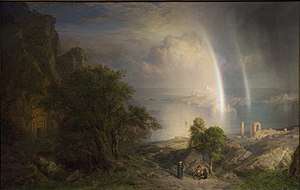The Aegean Sea
The Aegean Sea is a c. 1877 oil painting by American artist Frederic Edwin Church, and one of his last large-scale paintings.
| The Aegean Sea | |
|---|---|
 | |
| Artist | Frederic Edwin Church |
| Year | c. 1877 |
| Medium | Oil on canvas |
| Dimensions | 137.2 cm × 214 cm (54.0 in × 84 in) |
| Location | Metropolitan Museum of Art, New York City |
Description
The painting measures 54 by 84.25 inches (137.2 cm × 214.0 cm). It is a capriccio inspired by Church's travels to Europe and the Middle East from 1867 to 1869. The composite image includes elements from sketches that Church made in different locations, including a rock-cut entrance from Petra in a cliff to the left, fallen capitals from the Temple of Bacchus at Baalbek in the lower left, Roman columns from Syria to the right, and in the distance across a body of water lie classical ruins that resemble the Acropolis of Athens or the Temple of Apollo in Ancient Corinth, and the dome and minaret of a mosque from Istanbul. In the foreground are three small human figures in conversation beside a road based on an oil study of three Bedouins. The cloudy sky is enlivened by a double rainbow.[1]
In this work, Church moved away from his usual naturalistic style to a more idealised style. The atmospheric effects that may be inspired by the paintings of J. M. W. Turner which Church had seen in London (although Church had already used a double rainbow in his 1866 painting Rainy Season in the Tropics). The work may also take inspiration from Turner's 1826 view of the Roman Forum. Church designed a gilded frame for the painting, decorated with an eclectic mixture of Middle Eastern motifs, including stars and rosettes, and egg-and-dart and other moldings.[2]
History
The painting was bought by the railway tycoon William H. Osborn, a close friend and supporter of Church, and bequeathed to the Metropolitan Museum of Art on the death of his wife Virginia Reed (Sturges) Osborn in 1902.[3]
References
- The Aegean Sea, Metropolitan Museum of Art
- Frederic Church, John K. Howat, p.170, ISBN 0300109881
- "The Aegean Sea | Frederic Edwin Church | 02.23 | Work of Art | Heilbrunn Timeline of Art History". Metropolitan Museum of Art. Retrieved 2016-09-27.